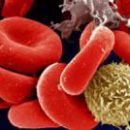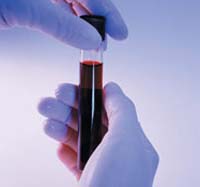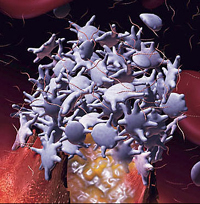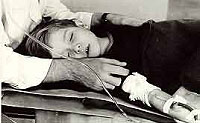Almost always hemophilia is only in men, and this is proven by people of any race and social status. The disease conveyed women who themselves do not have blood clotting problems. Let's understand why so?
Content
Who has hemophilia
Almost always hemophilia is only in men, and this is proven by people of any race and social status. The disease conveyed women who themselves do not have blood clotting problems.
Often the disease is not detected in children, as long as they start to crawl and walk. Inevitable in this period development of a child of falling and colliding with objects can cause bruises on the skin and bleeding from lips and languages.
At the age of 2-3 years in a boy with bleeding (hemorrhages), muscles and joints may be affected, which is accompanied by painful swelling or limited hand or leg movements. If at this time to introduce injections (injections) intramuscularly, as usual, it can lead to the formation of a deep extensive bruise, which may be dangerous. For a child with hemophilia it is very important to vaccinate, however, it can be safer than this can be done subcutaneously.
Disease inheritance scheme
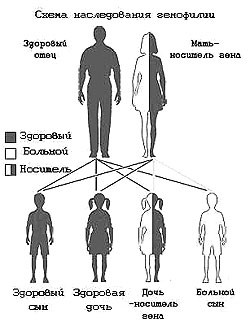 The human body consists of a variety of cells. Each cell has a regulatory center called the kernel: it contains chromosomes that form pair filamental structures. These structures determine the development of individual characteristics of each person.
The human body consists of a variety of cells. Each cell has a regulatory center called the kernel: it contains chromosomes that form pair filamental structures. These structures determine the development of individual characteristics of each person.
The most obvious person characteristic — It is his belonging to the male or female floor, and the manifestation of this sign affects the chromosome. The pair of chromosomes, which defines half a person, is called floor chromosomes, and they are still denoted by Latin letters X and Y. In women, the cell contains two x chromosomes (XX), and in men – one x and one y-chromosome (XY).
The child is inherited from each of the parents one chromosome, which determines the floor, and the result is four probable combinations of chromosomes received from parents (two are determined by the female floor and two – male).
Each chromosome consists of a variety of units called genes, which determine how the body functions. In addition, the X-chromosome determines half a person, it is also responsible for the formation of blood coagulation factors VIII and IX.
Those who suffer from hemophilia, these genes produce an insufficient number of blood coagulation factors VIII and IX, which explains the birth of boys with heavy bleeding in different generations of one family. At the same time, women of the same family do not suffer bleeding, since their second X-chromosome provides the production of a sufficient number of necessary factor.
In men (with a set of chromosomes X and Y) Y-chromosome does not take part in the production of factors VIII and IX. If the boy inherits damaged by the X-chromosome from his mother, it will suffer long bleeding, since its Y-chromosome cannot compensate the inability of the X-chromosome to provide a sufficient number of factors VIII and IX.
If the woman is pregnant with a girl, then there is one chance of two that the child will be transferred to the hemophilia gene, and then the sons of this girl will be born in the future with the disease of hemophilia, and the daughters will become carriers of the damaged gene. In other words, there is one chance of four that pregnancy will be resolved by a boy suffering from hemophilia.
If the father suffers from hemophilia, then all his daughters will become carriers of this disease. His sons will not inherit the disease, they will have a sufficient number of blood coagulation factors, and they will not transmit the disease hemophilia to their children.
If a man suffering from hemophilia, marries a woman who is a carrier of this disease, that is, the probability that they will have a daughter suffering from hemophilia. This is especially important to remember in cases where it comes to marriage between close relatives, for example, cousins and sisters.
What tests are used in the detection of hemophilia
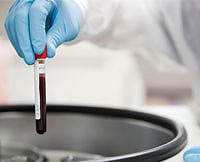 All analyzes are carried out only in specialized laboratories.
All analyzes are carried out only in specialized laboratories.
If the results of the analysis show that a woman has a low level of blood clotting factor, this will indicate that it is a hemophilia carrier, however, if analyzes indicate a normal level of factor, this does not exclude the likelihood that it is a carrier of the disease. Approximately 85% of cases of hemophilia carriers can be identified according to the results of the analysis of the family history, the level of factors of blood coagulation and the composition of the protein of these factors. However, the results of these analyzes are not considered, as absolutely reliable, and interpret them should be like probable.
Currently, it is possible to the most accurate establishment of carriage by direct analysis of genes (DNA analysis). To conduct it, you may need samples of the blood of the patient hemophilia, as well as several family members. If it is impossible to test the test at the place of residence, the blood samples can be sent to the clinic laboratory, where conditions allow DNA analysis. It is important to understand that the results of such an analysis must interpret the expert in this area, capable of fully explaining the woman who wants to know is it a carrier or not. An analysis does not give absolute proof of carriage, and more often can be provided only to the assessment of the probability of risk, and not a certain answer.
Diagnosis of hemophilia
Even if the boy has anomalous bleeding and among its relatives there are patients with hemophilia, the exact diagnosis can be put only in the case when the level of blood coagulation factors will be rated. This analysis should be carried out in the clinic laboratory, where there are relevant conditions and experience in conducting such tests.

